- Home
- Hearing Mechanism
Hearing Mechanism
ANATOMY AND PHYSIOLOGY OF THE EAR
What is the ear?
The ear is the organ of hearing and balance. The parts of the ear include:
External or outer ear, consisting of:
- Pinna or auricle. This is the outside part of the ear.
- External auditory canal or tube. This is the tube that connects the outer ear to the inside or middle ear.
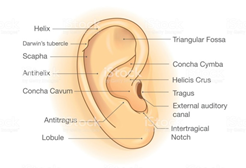
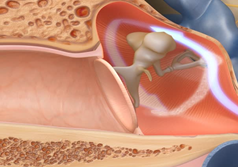
- Tympanic membrane (also called the eardrum). The tympanic membrane divides the external ear from the middle ear.
Middle ear (tympanic cavity), consisting of:
- Ossicles. Three small bones that are connected and transmit the sound waves to the inner ear. The bones are called:
- Malleus, Incus and Stapes
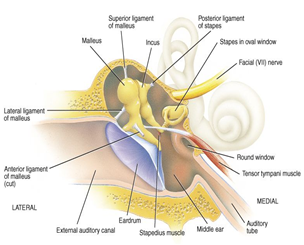
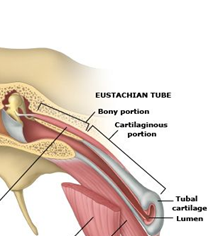
- Eustachian tube. A canal that links the middle ear with the back of the nose. The Eustachian tube helps to equalize the pressure in the middle ear. Equalized pressure is needed for the proper transfer of sound waves. The Eustachian tube is lined with mucous, just like the inside of the nose and throat.
Inner ear, consisting of:
- Cochlea. (contains the nerves for hearing)
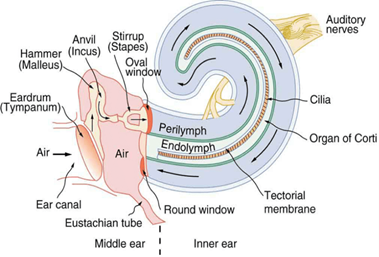
- Vestibule (contains receptors for balance)
- Semicircular canals. (contain receptors for balance)
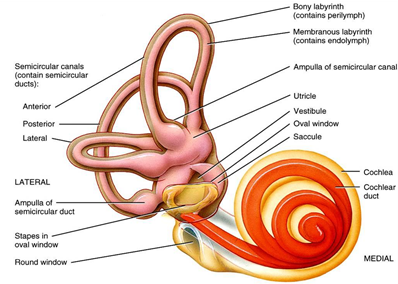
How do we hear?
Hearing starts with the outer ear. When a sound is made outside the outer ear, the sound waves, or vibrations, travel down the external auditory canal and strike the eardrum (tympanic membrane). The eardrum vibrates. The vibrations are then passed to three tiny bones in the middle ear called the ossicles. The ossicles amplify the sound and send the sound waves to the inner ear and into the fluid-filled hearing organ (cochlea).
Once the sound waves reach the inner ear, they are converted into electrical impulses, which the auditory nerve sends to the brain. The brain then translates these electrical impulses as sound.
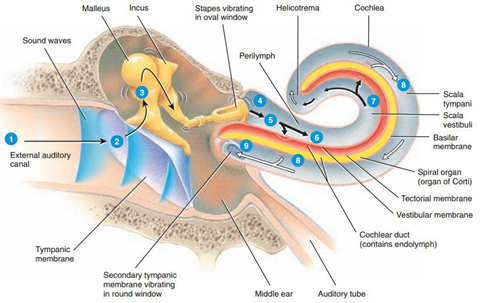
A person may be born with hearing difficulties, or they may be acquired due to multiple factors.
Hearing tests should always be performed by an experienced audiologist (a professional specialized in hearing), who will test hearing in order to determine the type, cause and severity. These tests vary according to the patient’s age and needs. The results are then discussed with the patient and/or their family.
The degrees of hearing loss vary from a mild hearing loss (affecting one’s ability to hear soft sounds) to a moderate, severe or even profound hearing loss (where the individual cannot hear most sounds).
Hearing loss also has types, according to the affected part of the ear. These include:
Conductive Hearing Loss
Any problem in the outer or middle ear that prevents sound waves from travelling naturally to the inner ear is known as a conductive hearing loss. Conductive hearing losses are usually mild or moderate in degree.
Sensorineural Hearing Loss
Which results from missing or damaged sensory cells (hair cells) in the cochlea (our snail shaped hearing organ) or neural hearing loss and is usually permanent. Sensorineural hearing loss can be mild, moderate, severe or profound.
Mixed Hearing Loss
This is a combination of a sensorineural and conductive hearing loss. It results from complications in both the inner and outer or middle ear.
Neural Hearing Loss
The least common of hearing loss types, resulting from the absence, damage or malfunction of the auditory nerve.
HEARING LOSS AND ITS TYPES
A person may be born with hearing difficulties, or they may be acquired due to multiple factors.
Hearing tests should always be performed by an experienced audiologist (a professional specialized in hearing), who will test hearing in order to determine the type, cause and severity. These tests vary according to the patient’s age and needs. The results are then discussed with the patient and/or their family.
The degrees of hearing loss vary from a mild hearing loss (affecting one’s ability to hear soft sounds) to a moderate, severe or even profound hearing loss (where the individual cannot hear most sounds).
Hearing loss also has types, according to the affected part of the ear. These include:
Conductive Hearing Loss
Any problem in the outer or middle ear that prevents sound waves from travelling naturally to the inner ear is known as a conductive hearing loss. Conductive hearing losses are usually mild or moderate in degree.
Sensorineural Hearing Loss
Which results from missing or damaged sensory cells (hair cells) in the cochlea (our snail shaped hearing organ) or neural hearing loss and is usually permanent. Sensorineural hearing loss can be mild, moderate, severe or profound.
Mixed Hearing Loss
This is a combination of a sensorineural and conductive hearing loss. It results from complications in both the inner and outer or middle ear.
Neural Hearing Loss
The least common of hearing loss types, resulting from the absence, damage or malfunction of the auditory nerve.
Effects of Hearing Loss on Child and Adults
Child development, It is well recognised that hearing is critical to speech and language development, communication and learning. The earlier the hearing loss occurs in a child's life, the more serious the effects on the child's development. Similarly, the earlier the problem is identified and intervention begun, the less serious the overall effect. Recent research indicates that children identified with a hearing loss who begin services early may be able to develop language (spoken and/or signed) at the level of their hearing peers.
There are four major ways in which hearing loss affects children and young adults.
- It causes delay in the development of receptive and expressive communication skills (speech, language and vocabulary).
- The language deficit causes learning problems that may result in reduced academic achievement.
- Communication difficulties often lead to social isolation and poor self-esteem.
- It may also have an impact on choice of vocation, or result in discrimination or negative attitudes towards a hearing impaired person.
Educational
Hearing impairment causes delay in the development of communication skills (speech, language and vocabulary). The language deficit causes learning problems that may result in reduced academic achievement.
Communication
The most significant difficulty for people who have hearing impairment is often problems in communicating with family, co-workers and friends.
- The person may ask others to repeat themselves more often or simply go along with the conversation.
- Conversations may be shorter and the telephone may be used less.
- The ability of an individual to carry out daily tasks is influenced not only by hearing ability, but also by other situational factors such as background noise, room acoustics, and familiarity with the situation.
- Such factors are important regardless of whether a person has a hearing loss, but the effects are magnified when hearing is impaired.
Hearing loss first causes a person to miss certain soft sounds: mostly consonants. The vowels are more distinct. The hearing loss causes letters to ‘fall out’ of the words or sentences. When a letter falls out of a word, a syllable is blurred or a word seems garbled. Consequently a person only hears part of the sentence, and may feel quite inadequate.
Hearing loss first causes a person to miss certain soft sounds: mostly consonants. The vowels are more distinct. The hearing loss causes letters to ‘fall out’ of the words or sentences. When a letter falls out of a word, a syllable is blurred or a word seems garbled. Consequently a person only hears part of the sentence, and may feel quite inadequate.
Communication difficulty has a flow-on effect, and influences other parts of their lives, such as work, recreation, socialising and participating in community events, health and wellbeing and safety.
Psychological Impact
Hearing loss is often described as an invisible disability. It can lower a person’s quality of life, and can have far-reaching psychological, physical and social consequences, especially if it is left untreated for any length of time.
Social
- The person may ask others to repeat themselves more often or simply go along with the conversation.
- Conversations may be shorter and the telephone may be used less.
- The ability of an individual to carry out daily tasks is influenced not only by hearing ability, but also by other situational factors such as background noise, room acoustics, and familiarity with the situation.
- Such factors are important regardless of whether a person has a hearing loss, but the effects are magnified when hearing is impaired.
Recreational
Hearing loss may mean that the person cannot participate in activities in which hearing plays a critical part, for example some sports, music, choir, drama. The presence of related conditions, for example tinnitus and balance problems, can limit the ability to participate in sport.
Emotional
Untreated hearing loss can cause people to experience a range of emotions.
- The person may ask others to repeat themselves more often or simply go along with the conversation.
- Conversations may be shorter and the telephone may be used less.
- The ability of an individual to carry out daily tasks is influenced not only by hearing ability, but also by other situational factors such as background noise, room acoustics, and familiarity with the situation.
- Such factors are important regardless of whether a person has a hearing loss, but the effects are magnified when hearing is impaired.
